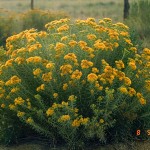Rayless Goldenrod, Jimmyweed, Southern Goldenbush
Isocoma pluriflora (Torr. & A. Gray) Greene
Asteraceae (Sunflower Family)
Description
Rayless Goldenrod is a low-growing half-shrub in the Sunflower family. It has erect stems that arise from a woody crown and grow to a height of 1 to 3 feet or 30 to 90 cm. The stems are light green to light brown in color. The leaves are sticky, hairless, narrow, and located alternately along the stems. The leaves may be light green to dull green in color and measure about 2 inches or 5 cm. The leaf margins may be entire or slightly toothed. The stems bear flat-topped clusters of yellow flowers from June through October. The floral heads are made up of only disk florets, no ray florets. Rayless Goldenrod is poisonous to livestock and provides poor forage for wildlife. It may provide shelter and a food source for some bird and small mammal species. With its brightly colored flowers, it is visited by pollinators and other insects.Habitat
This plant is often found on dry rangelands, especially in river valleys, along drainage areas, irrigation canals, overgrazed pastures, and on gypsiferous soil outcrops. It can be a problem for landowners in the Pecos Valley drainage area in southeastern New Mexico and western Texas. It usually grows at elevations of 2,000 to 6,000 feet and is found from southern Colorado into Texas, Mexico, New Mexico, and Arizona.Toxic Agent
Goldenrod can poison all species of livestock. The toxic agent is tremetone. The poison accumulates in the animal and is present in green and dry leaves, making the plant toxic year-round. The toxin in Rayless Goldenrod can be passed through milk. It is common for poisoning signs to appear in suckling young, but not in their mothers. Humans have been poisoned by consuming milk from affected cattle. Most poisoning cases occur in late fall or early winter but can occur year-round. A lethal dose generally consists of 1.0 to 1.5 percent of the animal's weight, consumed over 2 to 3 weeks.Signs of Livestock Ingestion
In cattle, this plant produces clinical signs often referred to as trembles. Muscular trembling is particularly noticeable in the nose, hips, and shoulders. Trembling is more pronounced after exercise. Stiffness and weakness are most pronounced in the forelegs. In later stages, the animal lies down and becomes unable to rise. Other signs may include: Constipation; Vomiting; Quickened and labored breathing; Almost continuous dribbling of urine. Shortly before death, the animal breathes with a prolonged inhalation followed by a pause and then a short and somewhat forcible expiration. Postmortem findings in cattle include: Congestion of the abomasum and intestine; Pale liver; Distended gall bladder.Management Strategies
Keep animals away from areas severely infested with Rayless Goldenrod. There is no specific treatment for poisoned animals. Remove them from the area of poisoning and give them good-quality hay and water. Purgatives and laxative feeds may aid recovery. Orally administering activated charcoal at 1 gram per kilogram of body weight may be helpful. Take calves and lambs off poisoned mothers. Discard all milk from affected females. Chemical control is achieved through aerial or ground broadcast methods in the fall. Good results have come from applying 0.45 ounces a.i./acre of Escort® or 0.5-pound a.i./acre of Tordon 22K®. Treat individual plants with a 1.0 percent v/v solution of Tordon 22K®.Images
Plant Characteristics
Flower Color: Yellow
Seed Type: Achene
Duration: Perennial
Stem Texture: Hairless/Smooth
Growth Habit: Forbs/Broadleaf
Leaf Shape
 : Simple with Pinnate or Parallel Venation
: Simple with Pinnate or Parallel Venation
Season: Warm
Distribution
 : 07 - Edwards Plateau, 08 - Rolling Plains, 09 - High Plains, 10 - Trans-Pecos
: 07 - Edwards Plateau, 08 - Rolling Plains, 09 - High Plains, 10 - Trans-Pecos
Distributions
Distribution refers to the ecological region in Texas that a plant has been found. You can also view a clickable map.
Book: Brush and Weeds of Texas Rangelands (B-6208), Toxic Plants of Texas (B-6105)
Collection: Brush and Weeds, Toxics, Wild Flowers
Livestock Affected: Cattle, Goats, Horses, Sheep
Livestock Signs: Abnormal Urination, Arched Back, Constipation, Depression/ Weakness, Irregular Breathing, Stiffness, Trembling, Unthrifty Offspring, Vomiting/Regurgitation







